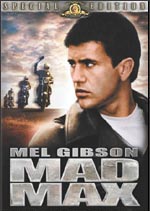
MAD MAX: SPECIAL EDITION
Reviewed February 4th, 2002 by David Nusair
The second half of Mad Max is so much more exciting and compelling than the first half, it’s easy to wish that it’s all there was of the film.
Though it was most likely incredibly daring and different upon its release in the late ‘70s, the post-apocalyptic world inhabited by the various Mad Max characters is now commonplace amongst these sorts of films. The twist here is that it’s never made clear what exactly happened to the world we know. So-called normal people are completely absent from this universe, with rebels and cops the only remaining citizens (with an occasional family passing through). These future cops, decked out in menacing black leather, spend their days patrolling the various highways on the lookout for trouble. Max, played by (of course) Mel Gibson, is the best officer there is; as the movie opens, he stops a seemingly unstoppable villain – by playing a deadly game of chicken. We soon meet Max’s family – his wife and young son – and discover that his tough-guy exterior is merely a façade for a caring husband and father. Until Max is forced into a mission of vengeance, the film doesn’t seem to be going anywhere. Car chases upon car chases are all well and good, but without some sort of a context to put them in, they tend to lose their meaning after a while.
That’s not to say the car chase sequences aren’t good; far from it. Despite an incredibly low budget, director George Miller infuses each chase scene with an energy that’s unparalleled even today (Ronin is the only recent movie to sport a similar high-octane feel). By mounting cameras to the cars, we’re put squarely in the action (and there’s no trickery here, either – one motorcycle’s speedometer can be glimpsed hitting a speed of over 60 miles per hour).
It’s these car chases that make the first half of the film tolerable, which is devoid of any interesting characters or situations. We’re dropped right into the middle of the action, without an explanation of why the world is the way it is or why the police now sport all-leather uniforms. But no matter – once the revenge plot kicks in, Mad Max takes off.
Audio: For a long time, if you wanted to watch Mad Max, you were stuck with the lame American dub. This release restores the original Australian soundtrack, and beefs it up with a 5.1 remix. The fact that you finally get to hear Mel Gibson’s voice is alone worth buying the disc, but MGM seemingly put a lot of work into this track. The many car chases sound great, with the various cars revving all around you and zooming by. But if you’d prefer, there’s also a mono Australian track and the American dub is even included!
Video: Presented anamorphically at a ratio of 2.35:1, this is a pretty fantastic transfer. If you’ve only seen this movie on VHS, you’ve really only seen half the movie. Director George Miller fills the screen with images, making it almost impossible to determine what’s going on in the pan and scan version. And this is a really impressive looking transfer, too. Given that it was filmed on such a low budget, it would have been reasonable to expect a lousy transfer. Not so. Mad Max looks vibrant and clean, and although the limitations of the transfer are evident on a few occasions (the movie is around 20 years old), this is certainly as good as it gets as far as Mad Max is concerned.
Extras: Though it may not have as many special features as other MGM releases, Mad Max still has a lot of stuff that’ll keep you busy for quite a while. The first disc houses two extras: a commentary track and a trivia subtitle track. The commentary consists of historian Tim Ridge, director of photography David Eggby, special effects coordinator Chris Murray, and art director Jon Dowding. And this is apparently the first time in a good long while that the three of them have been in the same room together. They quickly catch up and provide mostly technical information. This is an informative and compelling track, filled with a lot of interesting anecdotes. The trivia subtitle track is equally informative, providing tidbits that you wouldn’t have thought of (for example: Mad Max was the first Australian film to be shot in “scope”). Moving on to the flipside of the disc, there’s a couple of documentaries to be found here. First up is the 17-minute doc on Mel Gibson’s meteoric rise to fame after the release of Mad Max. A lot of this is just people involved with Mad Max talking about how great Gibson is, with the occasional film clip thrown in. Entertaining, but fluffy. Next up is the 26-minute featurette covering the success of the film throughout the world. This isn’t really a making-of doc as much as it’s a look at what it was about the movie that made it so popular (and anyway, everything you needed to know about the making of the movie was covered in either the commentary track or the trivia track). Rounding out the disc are a trailer, four TV spots, and a photo gallery.
Conclusion: Mad Max is one of the seminal action flicks, and this DVD presents it (finally) the way it was always meant to be seen.
Please help support our site by buying this DVD title
through this link. Thank you
kindly.
|


 Purchase
This DVD Purchase
This DVD
Story / Content

Audio

Video

Extras

|